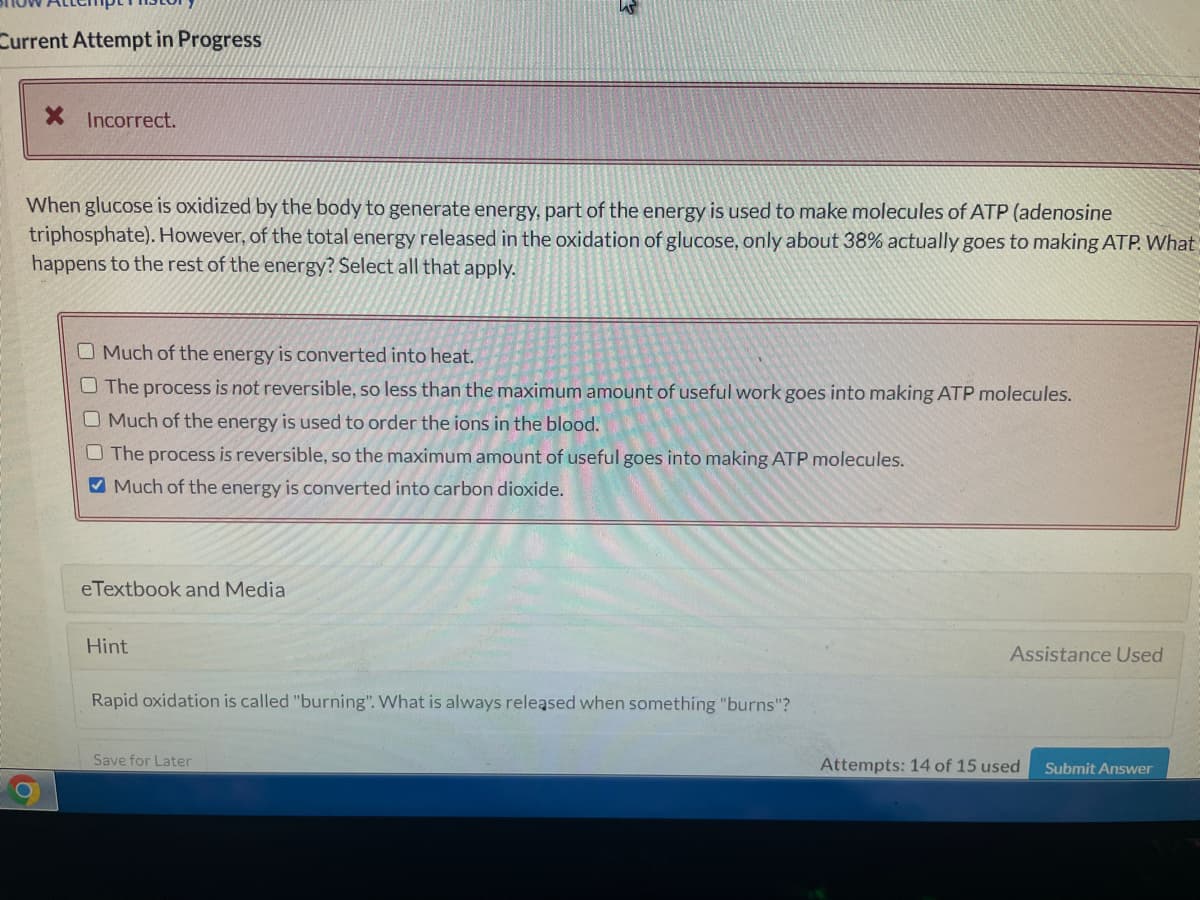When glucose is oxidized by the body to generate energy, part of the energy is used to make molecules of ATP (adenosine triphosphate). However, of the total energy released in the oxidation of glucose, only about 38% actually goes to making ATP. W. happens to the rest of the energy? Select all that apply. O Much of the energy is converted into heat. O The process is not reversible, so less than the maximum amount of useful work goes into making ATP molecules. O Much of the energy is used to order the ions in the blood. The process is reversible, so the maximum amount of useful goes into making ATP molecules. V Much of the energy is converted into carbon dioxide.
When glucose is oxidized by the body to generate energy, part of the energy is used to make molecules of ATP (adenosine triphosphate). However, of the total energy released in the oxidation of glucose, only about 38% actually goes to making ATP. W. happens to the rest of the energy? Select all that apply. O Much of the energy is converted into heat. O The process is not reversible, so less than the maximum amount of useful work goes into making ATP molecules. O Much of the energy is used to order the ions in the blood. The process is reversible, so the maximum amount of useful goes into making ATP molecules. V Much of the energy is converted into carbon dioxide.
Biochemistry
6th Edition
ISBN:9781305577206
Author:Reginald H. Garrett, Charles M. Grisham
Publisher:Reginald H. Garrett, Charles M. Grisham
Chapter27: Metabolic Integration And Organ Specialization
Section: Chapter Questions
Problem 10P
Related questions
Question
plz solve
2025 18 con

Transcribed Image Text:Current Attempt in Progress
X Incorrect.
When glucose is oxidized by the body to generate energy, part of the energy is used to make molecules of ATP (adenosine
triphosphate). However, of the total energy released in the oxidation of glucose, only about 38% actually goes to making ATP. What
happens to the rest of the energy? Select all that apply.
OMuch of the energy is converted into heat.
The process is not reversible, so less than the maximum amount of useful work goes into making ATP molecules.
O Much of the energy is used to order the ions in the blood.
O The process is reversible, so the maximum amount of useful goes into making ATP molecules.
V Much of the energy is converted into carbon dioxide.
eTextbook and Media
Hint
Assistance Used
Rapid oxidation is called "burning". What is always released when something "burns"?
Save for Later
Attempts: 14 of 15 used
Submit Answer
O O C
Expert Solution
This question has been solved!
Explore an expertly crafted, step-by-step solution for a thorough understanding of key concepts.
Step by step
Solved in 2 steps

Recommended textbooks for you

Biochemistry
Biochemistry
ISBN:
9781305577206
Author:
Reginald H. Garrett, Charles M. Grisham
Publisher:
Cengage Learning

Biochemistry
Biochemistry
ISBN:
9781305577206
Author:
Reginald H. Garrett, Charles M. Grisham
Publisher:
Cengage Learning